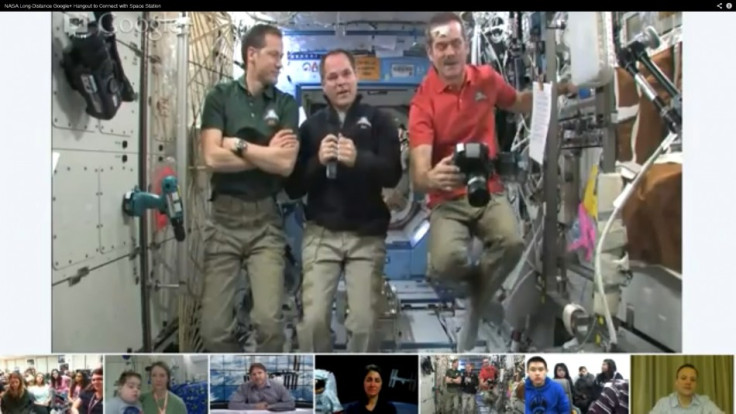Astronauts Host First Live Web Chat From Space

People from around the world have been asking astronauts questions in the first real-time web chat from space.
The Google+Hangout session with Nasa on Friday 22 February connected three astronauts on the International Space Station with audiences worldwide, who asked questions live via Twitter and Facebook, or pre-submitted them on YouTube. The questions asked of the astronauts, who are in orbit 250 miles above the Earth's surface, ranged from how to take photos in space to what life is like in zero gravity.
Canadian Space Agency astronaut Chris Hadfield said: "We are for the first time as a species leaving the planet in space stations and it is too good an experience not to share. With the technology that we now have we can real time communicate with pretty much everybody on Earth."
The video stream came three days after the $100 billion station lost radio contact with earth, and when asked how they coped, Hadfield said: "The space station is a robust, big space station. We worked together as a crew, following the procedure we trained to do, after just a couple orbits, we had the computers talking to the antennas properly so we could talk to the ground."
Expedition 34 commander Kevin Ford and flight engineer Tom Marshburn, both of Nasa, joined Hadfield in describing life in the craft, which orbits at a speed of approximately 4 miles (7.71km) per second.
When asked what other objects they can see from the craft, Marshburn said: "Shooting stars we do see but there is one big difference, they are below us not above us."
The crew are conducting a range of experiments on the mission, and Hadfield was rigged up with body temperature monitoring devices during the web chat, with scientists believing the information will help them understand changes to the body's circadian or natural rhythms in conditions where the crew see 16 sunsets and sunrises every day.
"The whole point of having a space station is to have some place in space where people can take their ideas," Ford told a high-school class in the American state of Iowa. "We have a huge power supply up here. We have a lot of rack space, and we have a lot of scientists on the ground with a lot of ideas of things to do in space."
In case of a medical emergency, the crews said, "Our station uses an ambulance and we would hop in the Soyuz [space capsule] and bring somebody home if we thought that they would have a real big problem or even die from a problem up here."
When asked what scientists he would most like to take with him, Ford replied: "Newton. Large objects that we can move with the push of a finger, small objects that bounce around very quickly, it is hard to believe that he was able to imagine these things and I would love for him to be able to see it."
The session lasted for 30 minutes; earlier astronauts Nicole Stott and Ron Garan had taken part in a 40-minute chat with Earth.
The station is currently manned by the three astronauts, along with three Russian cosmonauts.
The football field sized station is the largest structure yet built in space and was constructed by 15 different countries working under the direction of agencies from the US, Russia, Canada, Europe and Japan.
Work began on the craft in 1998 and it has been continuously manned since 2000.
Nasa also provides live video from the International Space Station via Ustream, as well as live audio.
© Copyright IBTimes 2025. All rights reserved.






















